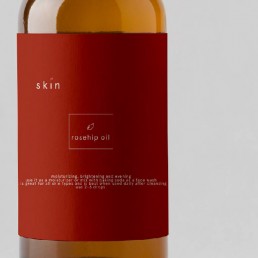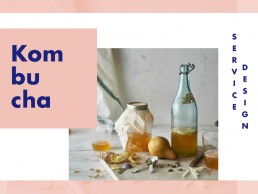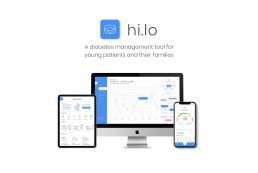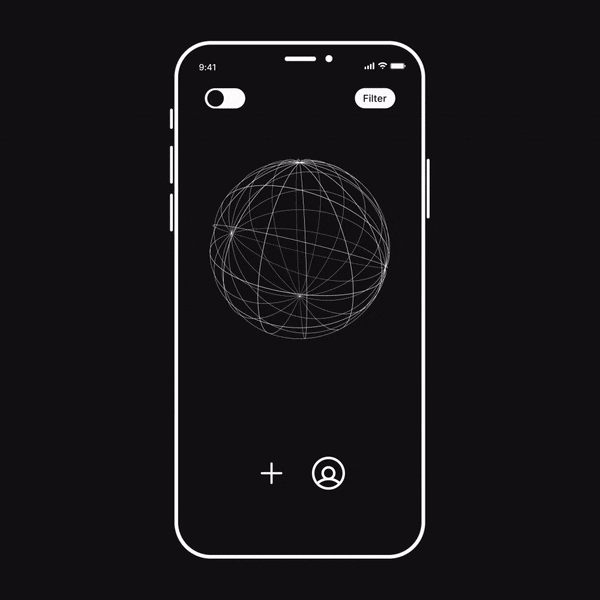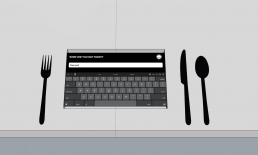Music in the Bones: Bone conducting adapter for earbuds
Kristina Mok | April 2015
A bone conducting adapter that attaches onto regular earphones to deliver stereoscopic sound to those with unilateral hearing loss.
For my empathy study, I stepped into the shoes of someone who is partially deaf. To simulate partial deafness, I inserted an earplug in my left ear. I had my hair down so that it would cover it an d hide it from people, so it wouldn’t change the way people would act around me.
When I used the computer, the experience was a lot different then what I was used to. Something as simple as watching a video on youtube was uncomfortable because it felt like the sound was coming from a far away source. As such, I had to fully concentrate on the video.
I was on high alert at all times while walking down the street because the cars would sound like they were still a good distance away but would be zipping past me the next second. Since I was walking by a busy street, I had to constantly scan my environment to ensure my safety.
One of the thing that bothered me was how every step and every movement of my jacket as I swung my hand sounded really loudly in my ear. I’m not sure if this echo is actually experienced by people with partial deafness, but if it is, I would certainly not be used to it.
• Complete hearing loss in left ear
• Doesn’t wear hearing aid
• Can hear stereoscopic sound when music source is placed on the left side of her jaw (bone conduction)
• Developed unilateral sensorineural (nerve) hearing loss due to a side effect of a drug when she contracted meningitis at 4 years old
• Complete hearing loss in her left ear but still has full hearing in her right
• Doesn’t wear hearing aid or use any assistive communica- tion tools
• Little changes to positioning when listening to a speaker (e.g. walk on the left of the speaker)
• Can hear stereoscopic sound when a music source is placed on the left side of her jaw (bone conduction)
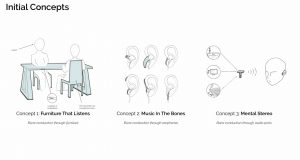
What is hearing loss?
Hearing loss, or deafness, is a general term that refers to the partial or complete loss of hearing in one or both ears.
There are many causes of deafness, some of which include genetics, contracting disease or virus, or exposure to loud noise. It can occur at any age and to anybody. It is a misconception that people who are deaf cannot hear at all. In fact, those with mild to moderate hearing loss are still able to hear sounds, albeit unclear and less intense than the original stimuli.
The majority of people with hearing loss can use assistive audio devices like hearing aids to amplify the surrounding sounds and voices. One factor for choosing the appropriate device would be determining the type of hearing loss.
Conductive hearing loss (mechanical)
• Effects ear canal, ear drum, or the 3 inner ear bones • Mechanical damage (e.g. ear drum or 3 inner ear bones don’t vibrate in response to sound)
• Bone conduction works better than air conduction
Sensorineural hearing loss (nerve)
• Effects cochlea, cochlear nerve, semicircular canals • Tiny hair cells (nerve endings that send signals to brain) are injured and do not work correctly
• Cannot be reversed in certain cases
Preliminary Research
Bone conduction
What is bone conduction?
Bone conduction is the transmittance of sound through vibrating bones.
This type of sound transmission works best for people who have conductive or unilateral hearing loss as one working cochlea is able to pick up on the resonating sound. Bone conducting devices act like an external ear drum and are the most effective when placed on the temple, jaw, and areas around the ear.
Preliminary Research
Bone conduction experiment with co-creator

Purpose: to conduct an experiment with my co-creator to locate the primary location(s) for bone conduction for audio transmission. Materials: earbuds and a music player
Experiment variables: volume, position of earbuds on the face, covering and not covering the right ear (the hearing side)
Concept 1 Feedback
Furniture That Listens: localized sound capturing in dining environments
Guest critics:
• Relevant design space as there is a large problem with hearing aids today picking up background sound in restaurant settings • How is the product marketed and to whom (restaurants, individual users, etc.)
Grace from Western Institute of the Deaf and Hard of Hearing:
(note: I presented to her my 3 concepts in my meeting with her this morning before presentation)
• Relevant problem space
• FM microphone can pick up vibrations coming from the table or chair (any hard surface that the microphone is attached to)
- Be aware of the location of embedded technology
• Elevate FM microphone away from the table
• Existing stand alone FM systems would work better than this concept because of less physical obstruction and hindrance with the table.
Concept 1 Feedback
Furniture That Listens: localized sound capturing in dining environments
Guest critics:
• Relevant design space as there is a large problem with hearing aids today picking up background sound in restaurant settings • How is the product marketed and to whom (restaurants, individual users, etc.)
Grace from Western Institute of the Deaf and Hard of Hearing:
(note: I presented to her my 3 concepts in my meeting with her this morning before presentation)
• Relevant problem space
• FM microphone can pick up vibrations coming from the table or chair (any hard surface that the microphone is attached to)
- Be aware of the location of embedded technology
• Elevate FM microphone away from the table
• Existing stand-alone

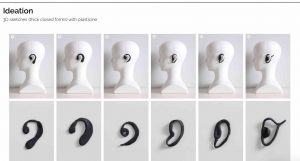

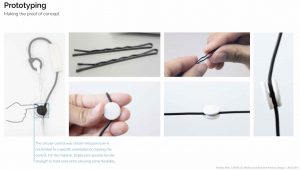

FM systems would work better than this concept because of less physical obstruction and hindrance with the table.
Concept 3 Feedback
Mental Stereo: Portable device that plugs into any audio port
Guest critics:
• No feedback on concept 3 (maybe unclear or not as interesting)
Grace (WIDHH):
• Similar technology is being developed by large companies like Oticon as there is an increasing demand for miniaturizing hearing aids and making it universal for multiple products.
• Bluetooth or 2.4 gHz technology would work best for this system
• An existing technology called the streamer does something similar to this. Although it’s bulky and worn around the neck, it picks up signals coming from different devices and uses bluetooth to relay the connected signal to the hearing aid.

Second Presentation Feedback
Feedback from guest critics
Laura:
• Helpful to show precedents to contextualize what exists right now and why I am pursuing this project. - What makes my product different from the existing ones.
Ian:
• There could be different ways of attaching the adapter. One suggestion was to attach to glasses as it gets away from the adapter from looking too much like a hearing aid. - Could attach to the ends of the glasses since there needs to be pressure applied for bone conduction to work
- Especially since my co-creator wears glasses, attaching it there would be relevant.
• Had a hard time understanding what bone conduction is.
Lucia:
• Material exploration
• Helpful to see earbud being used with prototype

Nourishment: System of Food Banks
Nourishment Project
by Michael Peter
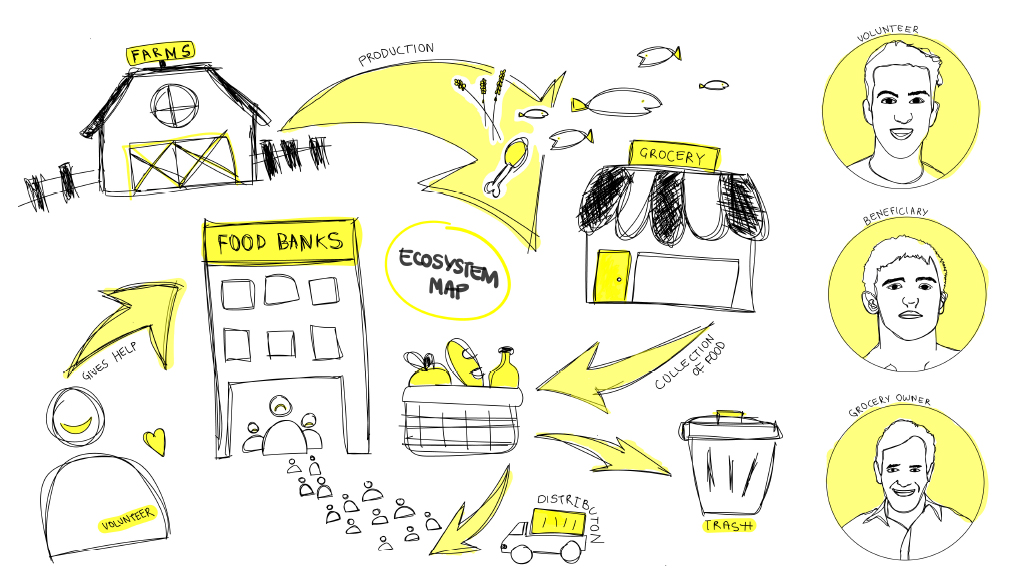
"How might we reimagine, a sustainable & efficient system for nourishment, between the collection & distribution sector, of food banks?"
Design context
This project allowed me to understand, develop, and use Service Design tools in a real-world scenario, building a participatory and empower service for food banks. I focused the service on the connection between the food donors and the food banks.
Design Artefacts

Information Broadcast-- My service is introduced through emailed flyers with follow-up phone call.
Mobile Application-- The grocery store owners can use this app to locate available volunteers, photo request a pickup, and rate volunteer. The volunteer will be able to update the availability and transportation, check the inventory of food banks and navigate the destination.
In-house Logistics Screen-- This screen provides arrival alerts and inventory overview. Logistics could also be housed through the mobile application.
Inventory Tracking-- The tracking system can weight and scan and integrate with the logistics screen.
Volunteer Reward System-- Volunteer will receive points after delivery the food and sponsor redemptions.
Gilligator
A Breathing Apparatus For Fish During Surgery
GILLIGATOR
Just like humans, animals need medical attention too. Artificial limbs, surgical tools and specialized equipment are all tools that veterinarians utilize when treating animals. It is difficult to identify what needs are important for animals since communication and language are not something that can easily be done.
The Vancouver Aquarium works closely with many marine animals and I have been working with them to create a medical device that will benefit both the animals as well as the vets.
The Vancouver Aquarium has recently worked been in the news with high profile animal rescues such as the False Killer Whale named Chester that was found near death and is currently doing very well, and giving a false eye to a fish that was a target of other fish for being easy prey.
Because I am working with animals and surgery, the veterinarians were not only my experts but also my co-creators. The vets at the Vancouver Aquarium have been giving me a lot of feedback as well as advice on how the animals interact with them and how they behave.
On my first trip to the Aquarium, Martin showed me around and we discussed possible design projects. These included:
- An x-ray stand that made it easier to move and lift while off-site and with large animals
- Something to hold a fish for injections without the need to anesthetize it
- An anesthetic tube to keep water going over gills during surgery
- An endoscope for retrieving swallowed objects within a bag to reduce scraping during removal
Martin Haulena
DVM, MSc, Dipl. ACZM Staff Veterinarian
Experts & Veterinarians
Justin F. Rosenberg
DVM
Veterinary Fellow
Ruby Banwait
Primary Aquariest / Caretaker
Chelsea De Colle
RAHT
Senior Veterinary Technologist
Co-Creators
Great care was taken to interact with live fish from the Aquarium. Only fish that already needed to undergo a procedure were used in order to reduce stress for the animals.
My co-creators consisted of fish. 2 of these fish were live fish from the Aquarium that were undergoing procedures while the other 2 were salmon heads from the market that allowed me to explore without fear of harming the fish.
The live fish recovered from their surgeries and can be seen swimming around in their tanks at the Aquarium.
Just Keep Swimming
Yellow Tail Rockfish
Copper Rockfish
Smokey the Salmon I
Smokey the Salmon II
Fish Surgery
Fish are anesthetized in a small tank by dissolving medication into the water. Once the fish is asleep it is placed on the surgical table with a sponge to keep them moist. (1) The medicated water is pumped from below the table and through a tube that is placed in the mouth of the fish. The water is also oxygenated in this bottom tank. The water needs to flow over the gills to allow the fish to breath a well as keep it asleep. The water falls through a hole in the table and back into the tank below.
After surgery, the fish is placed in a fresh tank of water to recover and slowly wakes up where it can be observe before being returned to their regular tank.
Gills
Gills function similarly to lungs. They have many small filaments that form a huge surface area where oxygen can be gathered from water as it flows over them. (1 & 2)
12
Procedure
Above:
Some places put tubes directly into the gills but this can be harmful and rip the gills. It also doesn’t provide flow over the entire gill and doesn’t provide much oxygen.
DanielGleiberman EmilyCarr2015
Left:
A Yellowtail Rockfish undergoes surgery. It was startled when removed from his tank but was easily distracted with food and then sedated. When he awoke later, he was sleepy but not aware or scared.
Below:
Water is sprayed through the mouth and from the outside to flow over the gills of the fish to help it breathe.
Observation
My second trip to the Aquarium I observe two fish surgeries. The first was for a Yellowtail Rockfish that had a rash. This type of fish is common in the Aquarium and exploratory surgery is frequent to maintain the health of the fishes that live there. This fish needed to be moved into several positions that made it difficult to irrigate the gills. The second surgery was on a Copper Rockfish that had air in its bladder.
Both of these fish recovered from their surgery after about half an hour after it finished. The Yellowtail had a follow up procedure during one of my subsequent visits and had begun improving.
Fish Surgery
DanielGleiberman EmilyCarr2015
Co-Creation & Observation
12 Equipment
The equipment used at the Aquarium was mostly common materials.
Parts need to be small and flexible for use on a variety of types of fish. It needs to be low cost and durable as well as easily washed. PVC pipes and rubber tubes are available at most hardware stores and can be replaced quickly for little cost.
Surgery is done on a large sponge (1) to keep the fish wet while water with dissolved anesthetic is cycled from beneath (2) and sprayed through the fish’s mouth over its gills. This tube needs to be moved back and forth over both sides of gills and requires a n additional tech to be resent during surgery in a small room.
A tracheal balloon (3) was tried to keep the tube in place in the mouth but sharp teeth popped it after only a couple of uses. Splitters and sprayers have all been tried but fail to stay in place and fail to target the gills. (4)
Recovery
After surgery is done, the fish is placed in a tank of recovery water with extra oxygen until it wakes up. Water is swept gently into its mouth until it begins breathing on its own.
Return To tank
Once the fish is partially awake, it is returned to its tank to wake up and swim around. In some cases the fish is placed into a secondary tank to remain isolated if it needs to avoid other fish or if it needs to be observed longer.
Post-Op
Surgical Area
The surgical Area at the Aquarium is a small room with shelves filled with tools and medicines for different animals. The area has x-ray equipment, ultrasound, and laboratory tools for research. A larger room next to it has room for larger animals but most procedures for larger animals is done in or around their tanks. All the equipment needs to be lightweight and mobile.
Reducing the Number of People
In order to irrigate a fish during surgery, an additional vet tech is needed. This becomes a problem in such a small area and means there are more hands getting in the way.
I simulated being a fish out of water with a breathing tube by putting myself underwater with a breathing tube.
Empathy Study
Communication
Animals have different needs than humans. They also can’t communicate their needs with us very effectively. In order to better understand what type of problems I would encounter while designing for animals, I needed to experience them for myself. I spent some time observing underwater animals and researching how they behave. The whole world is different under water, from the way you breathe to the way you move, how sound travels, where you store your food, everything.
There was also the problem of communication during testing, how would I know if the animal was uncomfortable or in pain or simply bored? I tried all sorts of activities to help understand what animals experience.
Behaviour Observation
For 3 days I observed and shadowed animals. On the first day I observed fish and cetaceans at the Aquarium and made notes about how they interacted with each other. I also observed some of the animals that were recovering and getting surgeries. I learned that for most fish, it was easy to keep them happy with food and that they don’t really care what is happening most of the time but with mammals, you needed to earn their trust and understand that they are in charge until they allow you to help.
For the last 2 days, I shadowed my cat (Tim). First in the apartment to understand his normal behavior, then I took him outside and to the pet store to see how he reacted to human activities such as shopping or getting a haircut.
Most of the day was spent napping. This was actually much more difficult than expected as there was not a lot to do and I got bored very easily whereas my cat enjoyed it a lot.
Right:
Not being used to going out, my cat was mostly curious but also very skiddish around people and noises that were unfamiliar. It was very apparent that this change of environment was not an easy thing. He did enjoy his haircut and grooming though.
Empathy Study 2
Understanding Animals
With the help of the Aquarium I was able to interact with animals and see how they communicate. (1) Communicate was difficult but trained animals such as the sea lion pictured here had more patience and at least a small amount of knowledge of what I was trying to say. Other animals such as fish had little to no interest or understanding.
I also went underwater (2) to see how animals needed to move differently than those that move in air. Range of motion was different and the ability to move up and down as well as forward and back made the ability to move very different than I was used to.
Designing In The Dark
By trying normal activities while blindfolded, I was able to experience living with a disability and by observing my girlfriend doing the same, I was able to see how people act when they have lost their sight. (3) When you lose a sense that you are constantly relying on it is difficult to do simple activities such as walking around or trying to identify an
Ideation
I originally wanted to build the Endoscopic Retriever as I wanted to work with large animals but it had several shortcomings. It would be very expensive and very difficult to test. I decided to build a Gill Irrigation Device as it had a larger potential benefit and be much more useful for the Aquarium.
Endoscopic Retriever
My idea is to design a cheap alternative to attach to the end of the endoscope that will cover the object and can protect the inside of the animal from any sharp ends or rough materials. A cheap disposable sheath such as a condom would be useful in helping retrieve objects safely.
Fish Surgical Table
This design would be an entire table for the vets to perform surgeries on. It would have a shape that allows for more space around the table in a small room, be easily transported, have built in lighting and a mister to keep the fish hydrated, as well as a tube to irrigate the gills and keep the fish sedated.
Gill Irrigation Device
During surgery, fish need to be out of the water but they still need to breathe. They are given water through a tube that must be waved back and forth to distribute water over their gills. This design would provide a way to irrigate both gills while holding the tube in the mouth and reduce the need to have an additional tech their to hold it.
3 Design Options
DanielGleiberman EmilyCarr2015
Flow control knob for easy pressure changing and to stop water
Grippy notches to hold in place
Flexible cone comes in different sizes and shapes for different fish and fits on snuggly
Flexible cone shape conforms to mouth
Mouth needs to be completely covered so that water doesn’t leak out
Gills Need constant water flow
What It Does Sharp teeth may cut softer materials
The Concept
Breathing Out of Water
Taking a fish out of their tank can be difficult, I aim to find a way to help them breath while undergoing surgery, which usually takes place on an operating table out of the water.
Sprayer
Water Delivery
There are several ways to deliver water within a fish’s mouth. I needed to consider the fragility of gills but still have something that fits in the mouth and provides enough pressure to distribute water all over. I really wanted to use a balloon type of system with a strong but flexible material that would inflate with water. (1)Flexible materials such as silicone or PET would work to direct the flow of water while blocking the opening of the mouth.
Functions
I wanted to incorporate other possible functions into the device so that the vets could use it more universally. Directional and different nozzle tips were a possibility. (2)
A shut off valve on the device was an important consideration so that flow rate and pressure could be controlled. (3)
A splitter was also important so that water could also be sprayed over the fish to keep it hydrated while keeping only a single pump. Using a quick connect system with devices such as splitters and sprayers already incorporated made it easier to include them in the overall design. (4)
Hose connectors
- Quick release and attach - Cheap & easily available - Durable
Dental Tools
- Hold hose in place
- Must prevent water from leaking - Stand up to sharp teeth
Gills
- Located in cheeks
- Need constant flow of water
- Gentle water flow to prevent injury
Tracheal balloon
- Doesn’t stand up to sharp teeth - Expensive
- But it does hold hose in place
Design Criteria
Primary Design Criteria
- Waterproof
- Saltwater & chemical resistant - Durable and teeth resistant
- Lightweight
- Adjustable flow rate
- Adjustable size/shape
Secondary Design Criteria
- Small / different sizes to fit into fish mouth - Flexible to bend to different shaped mouths - Inexpensive / easily replaced
- Grippy surface
- Non-porous / easy to clean - Flexible ball joint to spin
Tertiary Design Criteria
- Bright colored
- Easy to hold & handle
- Can be used with existing hose systems - 3D printed or molded with flexible plastic
How to Keep It in the Mouth
Reverse Clamp
A clamp with an adjustable width or spring loaded would keep the mouth open to different sizes. (1)
Rubber Stopper
A flexible stopper that can bend from a flat shape to fit into different sizes and shapes of mouth. This could be removable and replaced easily when it gets warn out.
Balloon
Similar to a tracheal tube, a balloon could be made of a thick material and inflate with water. It could spray out of small holes at the end.
Grippy
A hybrid of the stopper and a balloon, this would use flexible material in a ball shape but an open end. The water would be sprayed from a separate part while this conformed into the shape of the mouth to prevent water from escaping and to direct water flow towards the gills. It would be removable for easy cleaning and replacement. A grippy surface would keep it in place and stand up to sharp teeth.
Co-Creation
Sometimes the best way to find a solution is to take a step back from the problem. Working with tools from the garden, kitchen, and plumbing sections, we threw everything into a big pile and started to mix and match. Inserting things where they shouldn’t be and shoving stuff into a disembodied fish mouth.
Non-Experts
Bits & Pieces
Before starting to build, I needed to know how similar tools functioned. I took apart hoses and shower heads, garden sprayers with flow control, straws, tubes and anything that distributed water.
(1) The ball joint on a shower head can allow flow into any direction and allow for full rotations. This would be beneficial for the vets to reduce tangling while moving around the fish during surgery.
(2) Reinforcing angles help to keep this sprayer from bending or breaking when being used.
(3) A wide spraying head with many holes for water would help distribute water while also increasing the amount of oxygen.
(4) Spring loaded triggers used on garden hoses can help to control the rate of spray but require constant pressure. Twisting the end can change the flow rate and pressure.
1
Hoses & Sprayers
23
4
Initial Prototyping
Foam
My initial prototypes were made of modeling foam with bits of tube in order to visualize my sketches. Some of these include dual heads with individual swivels, rubber stoppers and bumper pads to put on a clamp
Taking Things Apart
By taking things apart I could better understand how different parts functioned. I researched ball valves and splitters as well as spray heads and hoses.
1
23
CAD Prototyping
CAD
(1) There were many parts of my design that I modeled that never ended up getting made or didn’t work in the prototype stages. I had to work with interlocking parts and attachments. This helped me to understand which parts could be easily produced at home or 3D printed and which parts would need to be manufactured with different methods such as injection molding.
I also had to figure out tolerances of materials and stretch.
3D Printing
(2) I used 3D printing to make rapid prototypes to test materials, tolerances, sizes, and shapes.
After cleaning up my initial 3D sketches and models in CAD, I was able to 3D print them in different sizes with different shapes and angles.
Materials
3D prints were done in flexible PET, as well as rigid plastics such as ABS and PLS.
Print Failures Influence Design Shape
(3) There were a lot of print failures. I learned not only how to use 3D printers and different materials but also how different materials react to different conditions. For prototyping, this process was helpful but for a final product, more expensive and more exact processes would be needed.
Testing Different fish have different sizes and shapes of mouths so I needed to
find something that would work for a variety of types of fish. (1)
Adjustable
Keeping water in the mouth and flowing over the gills was a particular problem I needed to solve. Directional tubes could target the gills but may not work best. I would need to aim water at the gills while also keeping it in the mouth. (2)
Fitting
Lift & Clamp
This prototype was to use grippy material and an adjustable lifter to stay in place in the mouth while adjustable moving arms target the gills. This proved to have too many parts and pieces to easily clean and keep track of.
Keep the Water In
The sides of the mouth were left uncovered and any water that was not hitting the gills initially was leaking out of the mouth.
Adjustable
Ribs on the outside provide places to grip and keep the piece in place.
Taking inspiration from dental tools and snorkels, this design works like a funnel to block all open parts of the mouth while water sprays against it. The shape also directs the water towards the gills.
Pop On, Pop Off
This design uses a snug fit and ring to stay on a sprinkler head. It can rotate freely but there are no small parts.
Material
Made of flexible PET, this rubber-like material can stand up to sharp teeth without being hard enough to harm them. It can bend to fit the shape of the mouth and flex to keep its position in the mouth.
An additional piece of plastic for the fish to bite down on. This would help to keep the mouth piece in place.
Funnels
Bite Down
DanielGleiberman EmilyCarr2015
Flexible
Flexible material is soft and doesn’t harm the fish. It is capable of adjusting to different sizes and shapes of mouths but stiff enough to keep its shape and direct water towards gills.
Soft & Strong
The soft PET is strong enough to stand up to the sharp teeth that would be rubbing against it while not cutting or scrapping them. The material is non-toxic and water proof. Although the plastic I used will break down over long periods of time in water, a more expensive version can be medical safe. This isn’t entirely necessary at this point as the head is meant to be easily replaced and will only be used for short amounts of time during surgery rather than submerged 24/7.
Translucent
The material is translucent to help see the water flowing within and easily detect if there is a blockage.
Presentation
Throughout the process we presented our concepts and progress. I found that I needed to keep my presentations less cluttered and move my final piece front and center. I received a lot of feedback about explaining the concept more as it was very different than the human targeted designs that were more aimed at comfort and improving quality of life rather than as technical tools.
Design
Through feedback I learned that I needed to allow my design to be more intuitive and user friendly. It needed to be immediately apparent how to use and what to use it for.
Feedback
More Testing
Straight Out of the Horses Fish’s Mouth
Different shapes had different pros and cons but ultimately a single, but flexible shape worked best at filling the contours within the mouth.
Size and Shape
I found that my design was too large for smaller fish and too strong to bend in place easily. Designing smaller items would influence the final manufacturing method as it would require more precise and smaller parts. This would likely be accomplished with injection molding.
Testing
The smaller design was able to be used more effectively as it provided more flex and could more easily fit. Water still leaked out of the mouth rather than all of it going over the gills. This was due to extra room left for flexing but would also be reduced when used with the actual flow part.
One Piece At a Time
Since the spraying head didn’t need to be tested in place, we put the mouthpiece over the existing tube so that we could see what was happening. The mouthpiece stayed in place effectively and blocked most of the water from escaping and didn’t harm the fish.
Smaller & More Flexible
The less parts that could break the better. Less parts also means less to clean and less to potentially break. The design consists of 2 main parts. The first is a mouthpiece, which is a flexible material that goes into the mouth that directs water towards the gills while also keeping water in the mouth. This is easily removed for cleaning or replacing. The second part is the sprayer, which consists of a shower-head like end, a flow-rate control in the middle, and an attachment on the end that can be connected to a hose either by quick release or by conventional hose screw.
Parts
Keep it Simple
Twist & Click
The only moving parts are twisting ones. The mouth piece pops onto the sprayer but can still rotate to accommodate moving the fish.
The top of the sprayer has an adjustable flow-rate that can be easily controlled on the fly.
The quick release was dropped in favor of a standard size screw lock for a couple of reasons. For one, it is more universal and can be used with any hose system. Second, it was easier to manufacture, with a shape that was easier to produce using various methods such as 3D printing and injection molding. Lastly, it is still compatible with the quick release system thanks to an adapter piece.
Click
The quick release system can be clicked into place for easy use. By removing this from the sprayer head, it becomes easier to use with a standard hose system if needed.
Moving Parts
Flow control knob for easy pressure changing and to stop water
Final Piece
(1) Made of a strong but flexible plastic, this part goes inside the fish’s mouth and keeps the water from leaking out. It holds the whole device in place and makes sure the water goes towards the gills. It can rotate to prevent tangling.
Sprayer
(2) The main body of the device, the sprayer has a flow control valve to turn on and off the flow of water while also being able to control the pressure of the water to adjust it for different fish.
Connector
(3) The end of the Sprayer, this has a screw that fits into most standard hoses. A quick connect can be added to allow for use with more parts.
Mouthpiece
Flexible cone shape conforms to mouth
Final Piece
Final manufacture of this gill-irrigator, or “Gill-igator” for now remains in small production but I hope to expand on it and have it injection molded and in the market.
A second prototype will be given to the Vancouver Aquarium and used over the summer for long term testing. After that, I will make any small additional changes that may be needed. I will continue to keep in contact with the Aquarium and I hope to work with them for my Grad Project on a similar device.
Production
If the long-term testing is successful I will meet with a patent lawyer and begin the journey to mass production. Hopefully this device can help aquariums and marine biologists around the world to make performing surgery on fish much easier.
Where To Now?
Thank You
Thank you to Anne MacCallum, Ian Denison and everyone at GF Strong rehabilion center for your insight into assistive care. Thank you to the girls from Snugvest and all of the people who came in to critique our class. Thank you to the 3rd year ID class for constant feedback and ideas and especially thank you to Eugenia Bertulis for putting up with me being constantly behind schedule and allowing me to work outside of the norm for this project. Extra thank you to my girlfriend Elena Syrovatkina for helping me with all of my empathy studies, making sure I ate and slept, and gave me feedback the whole way.
More Thanks
I would like to give a huge thank you to all of the staff at the Vancouver Aquarium that helped me out with everything during this project, from showing me around and how everything works to introducing me to the animals. Special thanks go to Justin Rosenberg, Ruby Banwait and Chelsea De Colle for their involvement and Martin Haulena for putting up with my countless emails and finding time in his schedule for me.
Arrr Arr, Blub-Blub, Meow-Meow
Thank you to all the animals that let me hang out with them and learn from them, including Tim the cat, Tikvah the sea lion, Chester the whale (who didn’t really help but gave me an appreciation for the sheer size of some of these animals) and the numerous fish that helped me test everything.
None of the animals that were alive were harmed however, the two salmon heads I got from the market started out dead and went on to be someone’s very delicious dinner.
Nourishment: Skin
Nourishment Project
by June Tang & Ginnie Morse
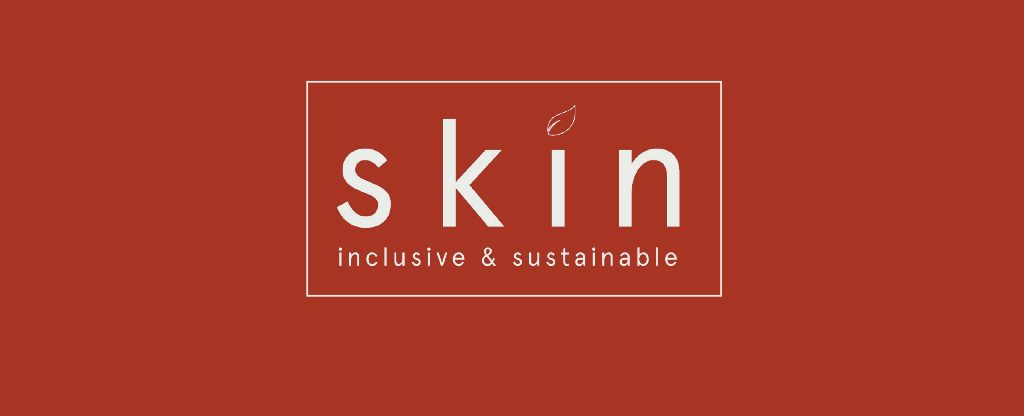
"How might we redesign the skin care experience for all genders and races of users so that they can feel included and accepted in the community of self-care? How might we also make skincare more sustainable to match the practices of eco-friendly users and optimize usage without or with minimal waste?"
Design context
Through a movement starting at the source, skincare should be designed for sustainability and longevity. Prices are already going into aesthetically pleasing packaging, resources just need to be produced to allow users to refill bottles of products opposed to single use. Branding and advertising must also make a change, with its focus on women, skincare, and self-care in general need to become more inclusive and accepting spaces. This will allow all people to safely navigate a space in which self-confidence and knowledge can be found, as well as the community, support, and positive relationships with ones-self.
Design Artefacts

Physical Store-- Essentially, customers enter the store and see the sampling section. Afterward, customers can head to the container section, or clean their own container at the cleaning station first. They then measure the empty container and fill products at the bulk section. We designed everything in gradual order, so customers do not have to be interrupted while doing any step. Moreover, in order to let customers can navigate the store by themselves, we created the instruction manual of how our own store operates.

Skincare Seminars-- These seminars are facilitators for conversations, discussions, and places where people just meet to talk. People do not have to just talk about skincare either! Skincare does not just have to be about healthcare. It is a ritual that helps people relax after a long, stressful day at work, and to be able to do this ritual with someone else and share your stories with them.
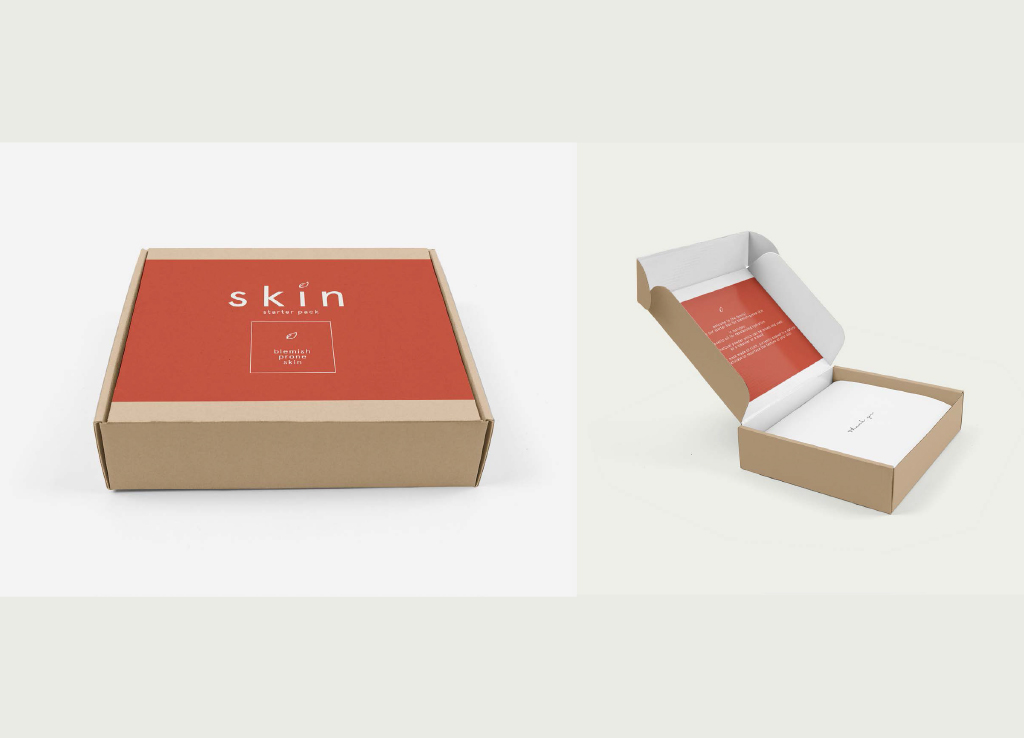
Skincare Subscription Box--If people do not want to go into the store and interact with other people, they can get our subscription boxes that are carefully curated for different types of skin concerns. The products only come with reusable containers and packaging, and they can bring those containers in to refill or simply recycle them. This is a way to give customers a personal and customized skincare experience that gives them comfort.

Reusable Packaging-- Customers will reuse those containers to refill our skincare product.
Nourishment: Kombucha
Nourishment Project
by Xinmiao Zhang

"How can I redesign both the DIY and store buying experience for kombucha lovers?"
Design context
I accidentally bought Kombucha once in the grocery store and the smell and flavor were completely new and kind of shuck to me. After researching it, I discovered that Kombucha is a kind of superfood and there is a group of people who love drinking Kombucha and DIY kombucha because of the healthy factors and the flavors. However, the means and ingredients to handmake Kombucha are hard to get. Therefore, I thought it will be interesting to do a project on it and let more people know more about Kombucha and easy to make by themselves.
Design Artifacts

DIY Space--the use of warm colour and soft materials is ideal for my store. There should be a fireplace or television, windows for sunlight to shine through, shades, the big wooden table in the middle, soft sittings, and air conditioning for a comfortable environment.
Service Website-- By creating an account, the customer can manage, track, order, get in touch with us.
Delivery Truck--We transport locally and the truck will act as an advertisement while shipping kombucha to customers.
Packaging-- My concept for packaging is clean simple and heartwarming design. Sturdy cardboard box designed for different packaging of the drink: Glass bottles, paper box, dispenser, etc. The boxes need to have cooling pads inside to ensure the freshness of the tea.
hi.lo | Michelle Chan
This responsive digital platform aims to integrate family-centered care into diabetes management by demystifying the illness for young patients and empowering them with agency, while encouraging parents to provide the appropriate type of care and support.
Objective
Approach

Values
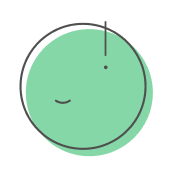
Redefine “child-friendly” content
Instead of patronizing cartoons and characters, employ accessible and engaging visuals.

Promote engagement in the diabetes community
Forming a community allows child patients to know theyare not alone and parents to share their tips and advices.

Encourage transparency and honesty
In other words, don’t sugar coat things.

Put the child in the middle of their own health journey
Let them be the main participant in their diabetes management.

Encourage caretakers to engage and support
Show them ways they can guide and help their child in an appropriate and non-invasive way.

Provide customizability + tailored content
Every person’s case is unique- narrowing and filtering down the material can reduce confusion and information overload.
Features



Video Prototype
Reflection
This project was an opportunity for me to explore many elements of designing a product. From participant recruitment and market research to participatory design and creating a platform with 3 responsive device screens, I think I explored quite a number of product design aspects.
The values that I had formulated from this round of research was very crucial to the project. I was excited to see that I was able to lay out the core fundamentals for designing for childhood diabetes management. I think the values really help set the goal for the project.

Michelle Chan
As a process-driven design practitioner and researcher, I am always looking for new ways to research and design to solve real-world problems. My goal is to formulate innovative methods that consider design-thinking and interdisciplinary collaboration. Throughout my career, I hope I can make important changes that will shift the health design culture.
As a student, I strived to explore types of art and design practices. I used each project to learn something new and develop my process of designing. I found passion in elements in interaction design that I loved, such as service design and design research.
Get Well | Bronwyn Proctor
Find a naturopathic doctor, meet with them remotely, and manage your records, completely online.
Scroll and click through the Get Well prototype above.
The Need

More and more people are choosing a more integrative approach to healthcare, and the complementary and alternative medicine market is growing fast. The market size is estimated to be $296.3 billion by 2027, and within that, naturopathy is one of the fastest growing therapies over the past two decades.
Virtual care, also called telehealth, is all the ways doctors interact with their patients remotely. The Canadian healthcare industry is looking at ways to shift towards providing more virtual care options. This focus will help to provide faster access to health care, and meet patient demand specifically for virtual healthcare.
We know the market is growing, more and more people are seeking out naturopathic care, but the discovery and delivery of care is not as accessible or convenient as it could be.
Searching
Finding a naturopathic doctor can be a confusing process and there is no easy way to try out a provider before committing to an expensive initial visit.
Location
Your provider choices are limited by location. If you want to see someone with specific experience, or you live in a remote area, accessing care becomes difficult.
Records
Delivery of documents and records from practitioner to patient are often not digital, or buried in email attachments. Keeping track of your own wellness progress can be overwhelming.
The Solution

Get Well gives patients of naturopathic care everything they need in one place. Find a naturopathic doctor, meet with them, keep all your records organized – all in one place.

Complete an intake questionnaire and choose from a filtered selection of naturopathic doctors.

Meet with your naturopathic doctor virtually with video, audio, or text visits.

All your records are organized and safe in your patient portal.
Reflection
As I was wrapping up this project, that I had been exploring for eight months, the world changed in a big way. When I started researching and interviewing people about virtual health in 2019, many people weren’t sure what it was. Some services were beginning to become available for conventional medical services, but there were definitely no options for complementary or alternative healthcare.
Now, with this global health crisis preventing people from accessing their chosen healthcare regularly, many practitioners are looking for new ways to continue to care for their patients.
While this period of time is mostly difficult and overwhelming, I’m excited about the future of health and wellness, and I’m excited to keep working in this field of design.

ABOUT BRONWYN
I believe design is about understanding people and their needs. I’m continually trying to reflect this belief in my work, and keep empathy at the core of my process.
Cometta, Cultivating Self Compassion by Arjun Menon
Problem:
There are many people who face self judgemental or self critical thoughts on a daily basis. These thoughts often become normalized in our lives and contribute to feelings of depression and isolation.
Solution:
Cometta(Co meaning together, Metta meaning loving kindness) is an app that will help you be mindful of your self critical thoughts and respond to them with kindness through a series of exercises. You can share this kindness by sending and receiving kind messages all over the world.
These screens showcase key UI outcomes of the product design process.
The top two screens present the feature to send and receive kind messages as a practice of compassion and recognition of our common humanity. The touch gesture of swiping up is given a meaning of releasing a kind message to the world. The movement of the user’s hands away from themselves signifies giving something to someone else. In order to receive a kind message from the world, the user has to accept it. The touch gesture of swiping down, or pulling towards themselves, signifies this acceptance of a kind message from someone else.
Micro-interactions guide the user’s experience in learning and applying the journey to cultivate compassion. These small product moments provide particular functions which come together in a usable, cohesive, and meaningful experience. In the bottom two screens, the micro-interactions allow the user to control visual and functional elements in their journey of mindfulness and kindness meditation.
Process
As the sole designer for this project I was responsible for a wide range of the design process from product concept ideation to, user research and UI/visual design.
Using user centered methods such as persona mapping, user interviews, and field research helped to challenge immediate assumptions in my early concept ideation and inform future concepts and designs.
I moved from low to high fidelity prototyping with testing and feedback for each prototype iteration. The insights from feedback I received during each testing session informed the design in terms of interface and layout arrangements as well as conceptual and experiential considerations. The approach to solving high level problems continued to evolve with new insights from user research which occurred throughout the design process as well. The final design outcome was determined heavily through this iterative and cyclical process.
Interactive Prototype
Ultimately the core experience of cultivating self compassion is amplified and communicated through micro-interaction, gesture and animation. A continuous challenge in the process was maintaining a balance between depth and simplicity of the experience in order to bring in more engagement and interest from users. Placing focus on the kind message sharing feature differentiates Cometta from existing mindfulness apps that might touch upon self compassion as a part rather than the whole of their offering.
About Arjun Menon
I am a class of 2020 graduating interaction design student. My hometown is the sunny San Diego, California.
My approach to design is influenced by my interest and practice of mindfulness.
In mindfulness meditation we become aware of the thoughts and patterns of our mind. Similarly, as a designer I try and be aware of the systems and assumptions we have during a project. I then validate through user centred research and design methods.
I believe the most creative work comes from a place of fearlessness and experimentation. With a strong foundational knowlege of design, I am able to push the boundaries and create captivating visual compositions using established as well as emerging technology. My love for design exploration, experimentation, and play allow me to constantly learn and ultimately create captivating interactions and experiences.
Check out my Portfolio: arjun1am.com
Eater's Digest
If food is essential for our survival- How do we feed our cities?
Critical Context
Modern lifestyle has gotten us off the right track, with fast foods, alcohol abuse, drug dependencies, a polluted environment and high-tech stress. Nature intended to fuel our inner healing force with the right natural substances to enable the body to function to its fullest potential. So how do we educate and empower a community of their diet?
An experimental survey invites eaters to sit and enter in their last meal eaten with Eater’s Digest. The average of all meals entered is converted into their individual nutritional composition, visualizing how a community is currently eating. Eaters are also invited to print their own Nutritional Fact labels, communicating information of their on meals.
Data Acquisition & Preparation

Canadian Nutrient File: Nutrient Values of Some Common Foods. Published by Health Canada, the Nutrient Value of Some Common Foods (NVSCF) provides Canadians with a resource that lists 19 nutrients for 1000 of the most commonly consumed foods in Canada.
Data Modelling & Visualization
A live horizontal bar graph clearly communicates how a community is eating, the nutritional composition of their diets.
Data Analysis & Reflection
Community-wide nutritional information is significant data. It can help us analyze deficiencies in diet, understand resources that a community may need to implement, and help us make informed food choices through a better understanding of the nutrient content of the foods we eat. This survey is location variable, and can be used to compare and contrast various community diets – based on location, climate, and culture. Nutritional Fact Labels serves its purpose in breaking down the nutritional composition of individual foods. Eater’s Digest helps bring new perspectives on what we consume, and why. Giving an opportunity for social innovation that builds resilient communities.

Michael Peter, 1998
Third-culture citizen with a global perspective, not afraid of taking risks or embracing uncertainty. His work is widely interdisciplinary, focused on building resilient societies, with experience in ceramics, interactive media, service design and, digital fabrication. His design process is greatly affected by research through experimentation; uncovering the new. He has a strong sense of fairness, justice, and respect for the dignity of individuals and communities through his designs. He is also highly reflective, able to assess and understand his strengths and limitations in order to support his learning and personal development. Michael is currently pursuing MRes Design at the Royal College of Art. Every day he looks for the excitement of what may occur in the realm of all possibilities.
www.linkedin.com/mikeiszen


